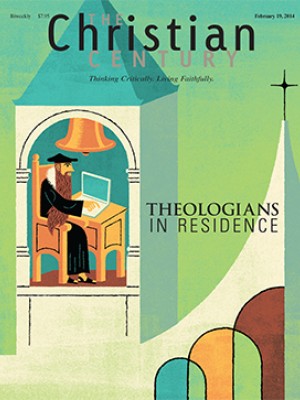Sunday, March 2, 2014: Exodus 24:12-18; 2 Peter 1:16-21; Matthew 17:1-9
I grew up in Southern Baptist congregations. By the time I left high school I knew the four steps to salvation and the meaning of Jesus’ sacrificial death as a substitutionary atonement for my sins. I could articulate this understanding of salvation in clear and simple terms. Within the metanarrative of evangelical Christianity it made perfect sense and was logically coherent.
Then my fundamentalism began to unravel. As an undergraduate religious studies major I was introduced to the historical-critical study of scripture. My questions accelerated into a full-blown crisis of faith that challenged everything I’d been taught. Unlike those friends who had found Christian faith too problematic to maintain, I was able to pick up the pieces of my deconstructed fundamentalism and discover a more progressive form of Christianity.
Read our latest issue or browse back issues.
During this time I was drawn to the Old Testament. As my fascination with the Hebrew Bible grew, I realized that references to the Old Testament had been largely absent from the evangelicalism of my youth. Yes, I learned the standard Old Testament Sunday school stories—Noah’s flood, Moses and the exodus, Jonah and the big fish, Elijah’s prophetic adventures, and David and Goliath. Otherwise, however, I’d read only selected quotations used in the New Testament or christological readings of portions of the prophet literature. Everything that I’d been told was important came from a rather narrow reading of the New Testament.
I realized that my understanding of salvation had nothing to do with the Old Testament. The Jesus of that salvation narrative existed in a historical vacuum that involved only a righteous but judgmental God, Christ the Savior and me. (I suppose the devil had a role to play, but only as a supporting character.) The story always began with human depravity and the punishment we deserve according to God’s justice—notions that probably were connected to a particular reading of the Hebrew Bible. But for the most part Jesus had no connection to Judaism and appeared out of nowhere to save us from God’s unflinching wrath.
Now I was learning about the rich depths of Israel’s sacred stories and the context of Second Temple Judaism. Without these, I realized, Jesus’ ministry doesn’t make much sense. I committed myself to teaching and preaching about Jesus within this context. I wanted to help others appreciate Jesus in light of the fullness of the biblical witness.
While all of this was coming together in my mind, I spent a year studying at the Hebrew University in Jerusalem and became immersed in the Hebrew Bible and Judaism. New Testament stories took on new life and new meaning once I knew the context in which they were first told and understood.
This Sunday’s story of Jesus’ transfiguration is a good example of why context matters. The similarities between the synoptic Gospel accounts of the transfiguration and the story of Moses on Mount Sinai are striking. In both stories the presence of God in the form of a cloud envelops a mountain, a traditional theophanic location. In both stories God’s voice provides a clear signal to the people that a significant revelation is taking place. On Mount Sinai the Torah is given to the people; in the transfiguration Christ is revealed as the embodiment of God’s word. The references and allusions are beautiful and compelling.
I went to Israel again after I’d been to seminary, worked on a degree in Hebrew Bible and served in parish ministry for over a decade. As I was climbing up the tell at Beit She’an, I realized that although my ecclesiastical context had significantly changed, the Jesus whom I preached now was disconnected from the Old Testament. Just as the Jesus of evangelicalism often exists in the vacuum of a salvation narrative, the Jesus of my mainline Protestantism often existed in a vacuum of social justice and peacemaking.
Jesus doesn’t need an Israelite or Jewish backstory to make sense in the evangelical or mainline universes. In both he is a sui generis figure who can accomplish a mission—personal salvation or social justice—on his own terms. But neither of these portrayals bears witness to the fullness of his story and the significance of his message. Both are impoverished caricatures of who Jesus was and is.
So what should we pastors do with this perennial tension? Does Jesus represent continuity with the past or a uniqueness that stands on its own? Both are represented in this story. While Jesus is singled out by the mystery of transfiguration and the manifestation of God’s glory and voice, Moses and Elijah are there to remind us that the story doesn’t take place in historical, narrative or theological isolation. The allusions to Mount Sinai and the presence of Old Testament heroes draw us into a sacred narrative that’s bigger than Jesus and Christianity.
How we tell this story is therefore critical. Although we may sometimes focus on the mystery and miraculous uniqueness of Jesus’ transfiguration, we must also remember to immerse our congregations in its rich, wider context.






